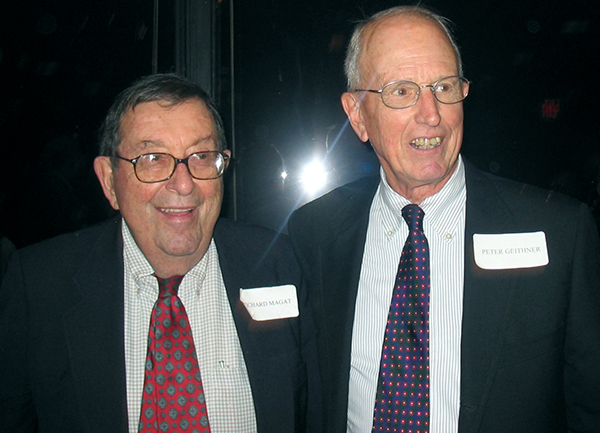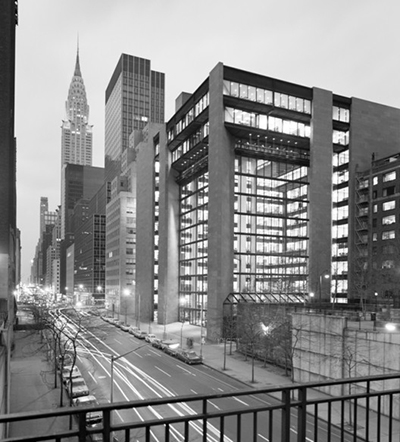NEWSLETTER
|
LAFF is 25, Join the Celebration
From that desire to re-create the “colleagueship” they had known at Ford came the idea to form an alumni group, and from that idea came the Life After the Ford Foundation Society.
Its purpose, said its principal founders, Richard Magat and Edward J. Meade, Jr., was “simply to circulate news of the professional and/or personal events of former staff members, thereby to remember old bonds, possibly renew acquaintances, and to help one another professionally”.
The society grew quickly, in large part because both men had spent the bulk of their careers at Ford and had a wide range of friends and colleagues they could contact directly. Dick, who later became president of the Edward W. Hazen Foundation, had been director of what was then the Office of Reports for 25 years. Ed, who died in 1994, was at Ford for 29 years, working primarily on education and then, until he retired in 1989, as the chief officer for the urban poverty program.
What started with a few has grown to nearly 500 members in all parts of the world, and many of them will be coming to New York City on May 17 to mark the 25th anniversary of that small but hopeful beginning.
The theme for the day: “Life After, and at, the Ford Foundation: Understanding the past to frame the future”.
A planning committee of both LAFF members and Foundation staff has been working on a detailed agenda for the day, which will be sent along with a formal invitation. Some events have been determined, though.
After people sign in and mingle over pastries and coffee, they will be welcomed by Darren Walker, president of the Foundation, and Shep Forman, president of LAFF. Dick Magat will recount the early days of LAFF.
Two morning sessions are planned, one being “A Walk Through the Foundation’s History” guided by Pat Rosenfield and Rachel Wimpee of the Rockefeller Archives Center, where Ford’s archives now are kept.
The second will look at the Foundation today, “All That’s New: Strategy, Learning and the Thematic Areas”, with Martin Abregu, Ford’s vice president for Democracy Rights and Justice, and Bess Rothenberg, director of the Strategy and Learning Unit.
During the lunch break Darren Walker will hold a conversation with LAFF members and Foundation staff, covering such topics as the Foundation’s work now, challenges facing philanthropic institutions, and the visions of the future.
There will be at least three “breakout” sessions in the afternoon, tentatively dealing with how foundations operate in a challenging era for civil society; the Changing Face of Philanthropy; and the outlook for grant-making in a charged United States political environment.
Before the day ends with a cocktail reception, those attending will have a chance to walk through the building to see again the physical space they once worked in before the building closes for two years for renovations, a project that will be explained in a separate session following the afternoon breakout meetings.
The building will be closed later this year to begin a $190 million renovation project necessitated by the need to bring the nearly 50-year-old structure up to current New York City building and environmental codes. It’s expected to be completed by the summer of 2018. In the meantime, the 375 employees will work in a building at 1440 Broadway, at 40th Street.
“We’re not only grant makers but stewards of a building that Henry Ford II commissioned and was deeply involved with,” Darren Walker said in a recent interview with The New York Times. “This building is part of our legacy and was a gift to the city. And I take that responsibility seriously.”
But the Foundation is taking advantage of the project to impose more modern sensibilities on the space within those walls and around the atrium.
“This building is not compatible with our culture as an organization,” Darren said. “It is hierarchical, off-putting and inaccessible.”
So, among other changes, the separated offices will be replaced by wide-open work spaces, a move that the original architect, Kevin Roche, endorses. “You get away from the idea of the isolation of the office and create a community,” he said, “which I subscribe to 100 percent.”
In addition, the presidential suite will be reduced by half, the space for non-profit conferences will be doubled, two floors will be made available for use by other non-profit organizations, and space will be provided for a new visitor center, an art gallery and open areas for visitors.
Some aspects of the building that made it special will be retained: the furniture will stay and, while all the plants now in the atrium will be replaced, new plantings will re-create the unique atmosphere of the central area.
On May 17, the building will be a vivid reminder of the past while the activities being planned will help both LAFF and the Foundation look toward the future.
|



